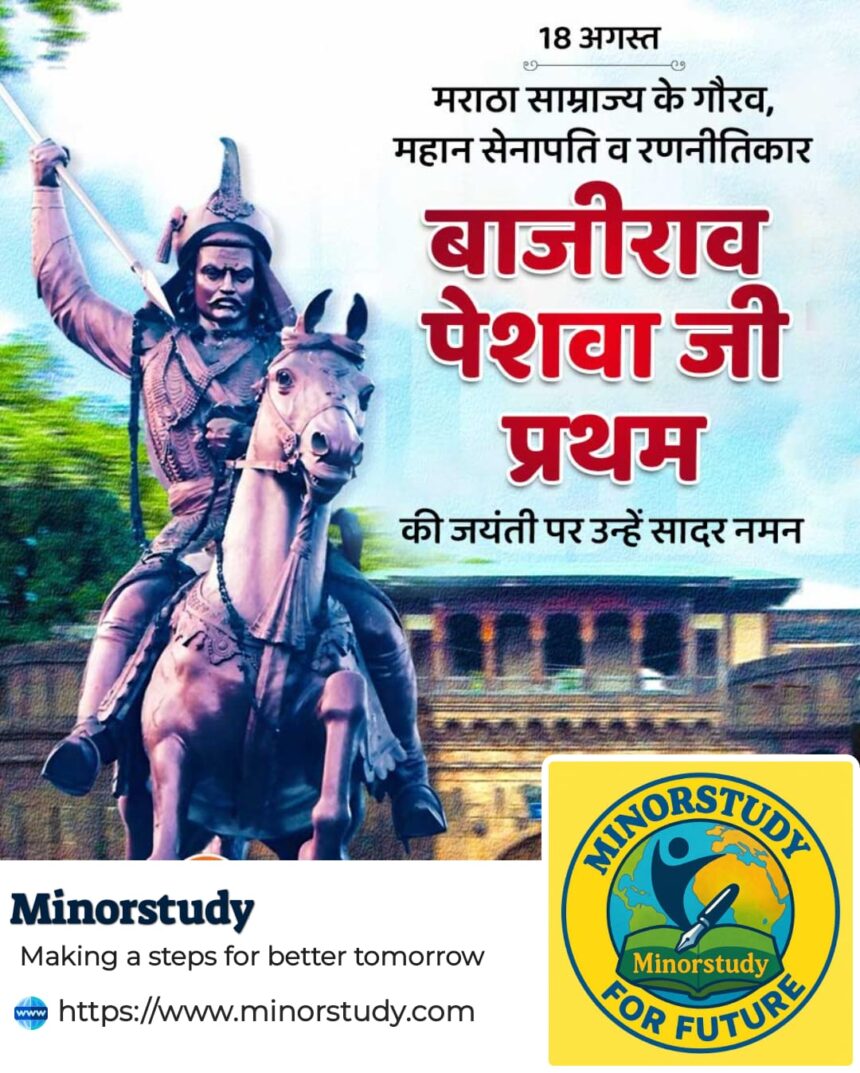10 Unstoppable Truths About Bajirao Peshwa I That Will Inspire Every Indian
Introduction
Indian history is full of heroes whose names continue to echo through time. Among them, Bajirao Peshwa I stands out as a legendary figure of the Maratha Empire, remembered for his unmatched military genius, administrative acumen, and visionary leadership. Known as the “Napoleon of India”, Bajirao was one of the greatest cavalry generals in Indian history who never lost a single battle in his career.
- Introduction
- History of Bajirao Peshwa I
- Key Facts About Bajirao Peshwa I
- Timeline of Bajirao Peshwa I
- Significance of Bajirao Peshwa I
- Bajirao Peshwa I in Our Daily Life – Lessons & Impacts
- Observance & Legacy
- Wishing & Remembrance
- FAQs About Bajirao Peshwa I
- Important Points to Remember
- Conclusion – Why Bajirao Peshwa I Matters Today
But beyond his military victories, Bajirao was also a man of passion, discipline, and ambition who reshaped the destiny of the Marathas and challenged the mighty Mughal power in the 18th century. His story is not just about wars and conquests—it is about courage, vision, and determination, qualities that continue to inspire us in daily life.
In this article, let’s explore everything about Bajirao Peshwa I—his history, important facts, timeline, significance, FAQs, his role in society, and the lessons we can draw for our lives today.
History of Bajirao Peshwa I
Full Name: Bajirao Ballal Bhat
Born: 18 August 1700, in Dubere village, Maharashtra
Father: Balaji Vishwanath, the first Peshwa (Prime Minister) of the Maratha Empire
Mother: Radhabai Barve
Died: 28 April 1740, Raverkhedi (Madhya Pradesh) at the age of 39
Bajirao Peshwa I was appointed as the Peshwa (Prime Minister) of the Maratha Empire in 1720 by Chhatrapati Shahu Maharaj after the death of his father, Balaji Vishwanath. Despite being only 20 years old, he displayed exceptional leadership skills. He soon transformed the Maratha Empire into the most powerful force in India.
Bajirao’s strategic brilliance lay in his swift cavalry movements, lightning raids, and innovative military tactics. His vision was to expand the Maratha Empire beyond Maharashtra and establish it as the supreme power across India.
Key Facts About Bajirao Peshwa I
Military Genius: Bajirao fought more than 41 battles and did not lose a single one.
Title: Called the “Napoleon of India” by historians for his military brilliance.
Expansion of Maratha Power: He extended Maratha influence into Malwa, Gujarat, Bundelkhand, and even threatened Delhi.
Bond with Mastani: Bajirao’s love story with Mastani, a half-Muslim princess, remains one of the most talked-about chapters of his life.
Administrative Role: He reorganized the Maratha empire, strengthened revenue collection, and ensured unity among Maratha chieftains.
Charismatic Leader: Known for motivating his soldiers with powerful words: “Remember that night is yours and day is your enemy.”
Religious Harmony: Though criticized for his relationship with Mastani, Bajirao is remembered as a leader who believed in courage, not caste or religion.
Death at a Young Age: He died at just 39 but left behind a legacy that reshaped Indian history.
Symbol of Courage: Even today, Bajirao is celebrated as an icon of bravery and determination.
Cultural Impact: His life story inspired books, plays, TV shows, and movies like Bajirao Mastani.
Timeline of Bajirao Peshwa I
1700: Birth of Bajirao in Dubere, Maharashtra.
1716: Trained in military skills from a young age; participated in early campaigns.
1720: Appointed as Peshwa by Shahu Maharaj after his father’s death.
1721-1730: Series of victorious campaigns against Mughals and Nizam of Hyderabad.
1728 (Battle of Palkhed): Defeated Nizam-ul-Mulk using swift cavalry tactics, hailed as a masterstroke.
1737: Bajirao reached the gates of Delhi, sending shockwaves to the Mughal throne.
1739: Victory in Malwa and Bundelkhand regions.
1740: Died suddenly near Raverkhedi at age 39 while on a campaign.
Significance of Bajirao Peshwa I
Architect of Maratha Supremacy: Bajirao transformed the Marathas from regional power to a pan-Indian empire.
Military Innovator: His fast-moving cavalry and guerrilla tactics influenced Indian warfare for decades.
Challenger to Mughals: Bajirao’s campaigns weakened the Mughal hold over India, paving the way for Maratha dominance.
Symbol of Youth Leadership: At just 20, he became Peshwa, proving that age is no barrier to leadership.
Inspirational Figure: His never-defeated record and fearless attitude make him an eternal icon of courage and leadership.
Bajirao Peshwa I in Our Daily Life – Lessons & Impacts
Bajirao’s story is not just history—it carries deep lessons for our personal and social lives:
Courage in Adversity: Bajirao teaches us to face challenges with bravery, whether in business, studies, or personal struggles.
Visionary Thinking: He looked beyond his time and boundaries. We too should aim big and not limit our dreams.
Leadership Skills: Bajirao united people with inspiration and strategy, a quality every leader and manager can adopt.
Balancing Heart & Duty: His bond with Mastani shows he was human, with emotions, yet deeply committed to his duties.
Discipline & Dedication: His strict military discipline reminds us that success requires focus and determination.
Observance & Legacy
Statues & Memorials: Statues of Bajirao exist in Pune, Delhi, and Raverkhedi.
Cultural Celebrations: Plays, films, and festivals in Maharashtra often honor his memory.
Historical Studies: Military academies still study his tactics as examples of brilliant strategy.
Tourism: Shaniwar Wada in Pune (built by Bajirao) is a famous heritage site.
Wishing & Remembrance
On occasions related to Bajirao Peshwa I—such as his birth anniversary or historical commemorations—people often share wishes like:
“May the fearless spirit of Bajirao Peshwa I inspire us to face challenges with courage.”
“Remembering Bajirao, the undefeated warrior whose legacy shines forever.”
Such wishes not only honor his memory but also remind us of the qualities we need in modern life: bravery, leadership, and vision.
FAQs About Bajirao Peshwa I
Q1. Why is Bajirao Peshwa I called the “Napoleon of India”?
Because like Napoleon Bonaparte, Bajirao was a brilliant military strategist who won every battle he fought.
Q2. How did Bajirao Peshwa I die?
He died of sudden illness (possibly fever and exhaustion) in 1740 while on a campaign at Raverkhedi.
Q3. What was the Battle of Palkhed?
In 1728, Bajirao defeated the Nizam of Hyderabad in a swift cavalry maneuver, which is considered a textbook example of mobile warfare.
Q4. Who was Mastani?
Mastani was Bajirao’s second wife, the daughter of Bundela king Chhatrasal and a Persian mother. Their love story is legendary.
Q5. What was Bajirao’s greatest achievement?
His greatest achievement was expanding Maratha power to Delhi and reducing the Mughal influence in India.
Important Points to Remember
Bajirao was appointed Peshwa at 20 and died at 39, yet changed Indian history.
He fought over 41 battles and never lost one.
He was both a warrior and a visionary, shaping Maratha supremacy.
His legacy continues in Indian culture, films, and military studies.
Conclusion – Why Bajirao Peshwa I Matters Today
Bajirao Peshwa I is not just a name in history books; he is a living symbol of courage, leadership, and vision. His ability to dream beyond boundaries, act with lightning speed, and inspire others holds lessons for every individual, whether a student, leader, or common citizen.
In our daily life, Bajirao’s legacy encourages us to:
Be fearless in facing challenges.
Think big and plan strategically.
Lead with confidence, even when the odds are against us.
Balance personal emotions with professional responsibilities.
The story of Bajirao Peshwa I is not just about the Marathas—it is about the power of human determination. Even centuries later, his example continues to motivate us, proving that true legends never die.
✨ Wishing:
May we all carry forward the fearless spirit of Bajirao Peshwa I in our lives—undaunted, determined, and undefeated.








